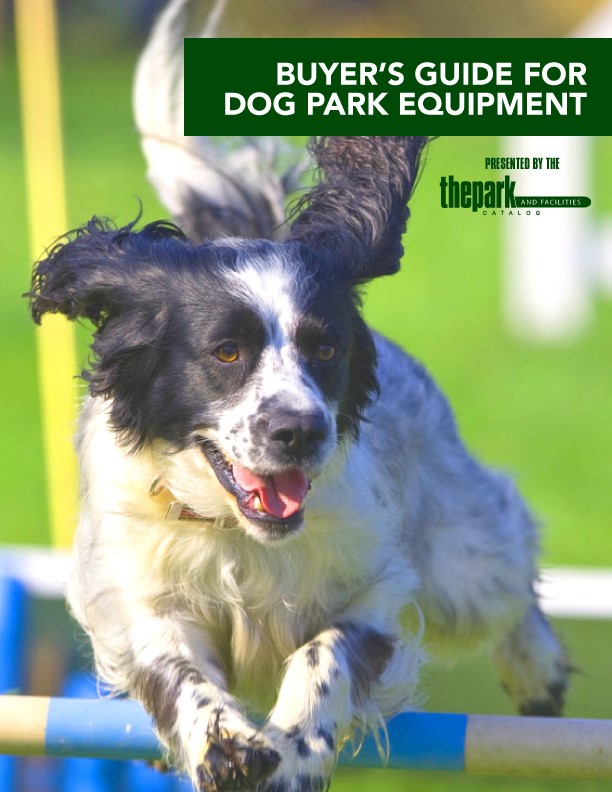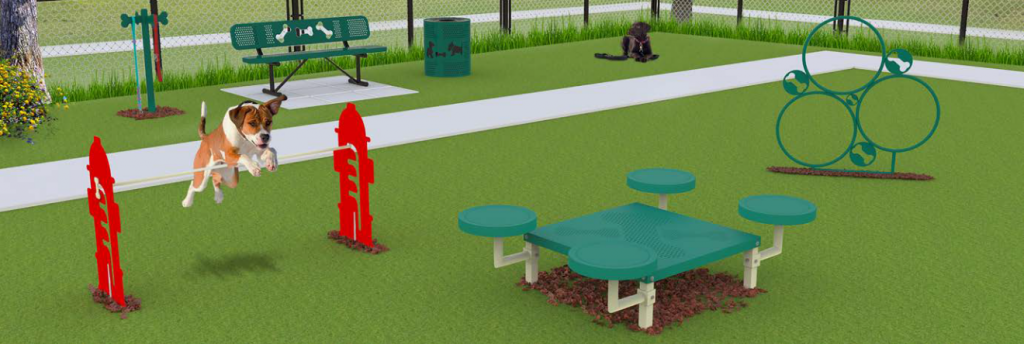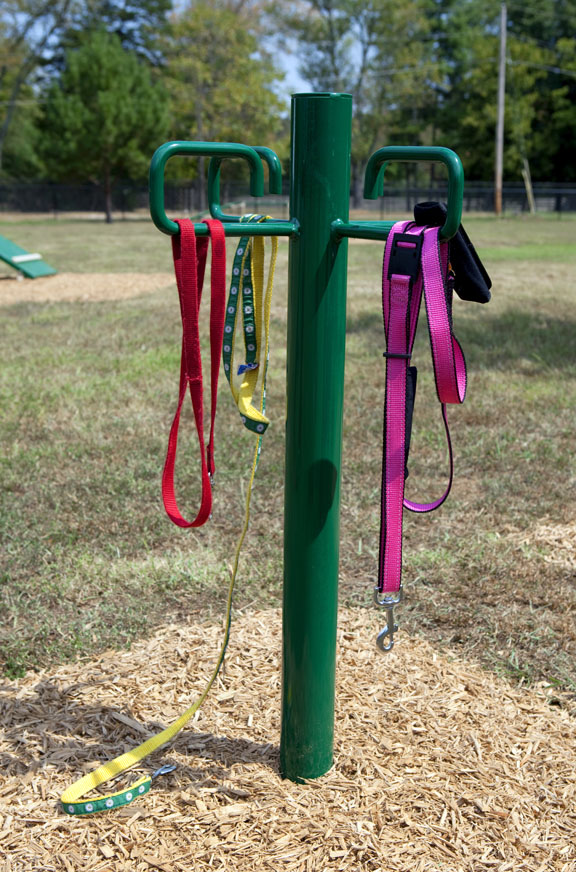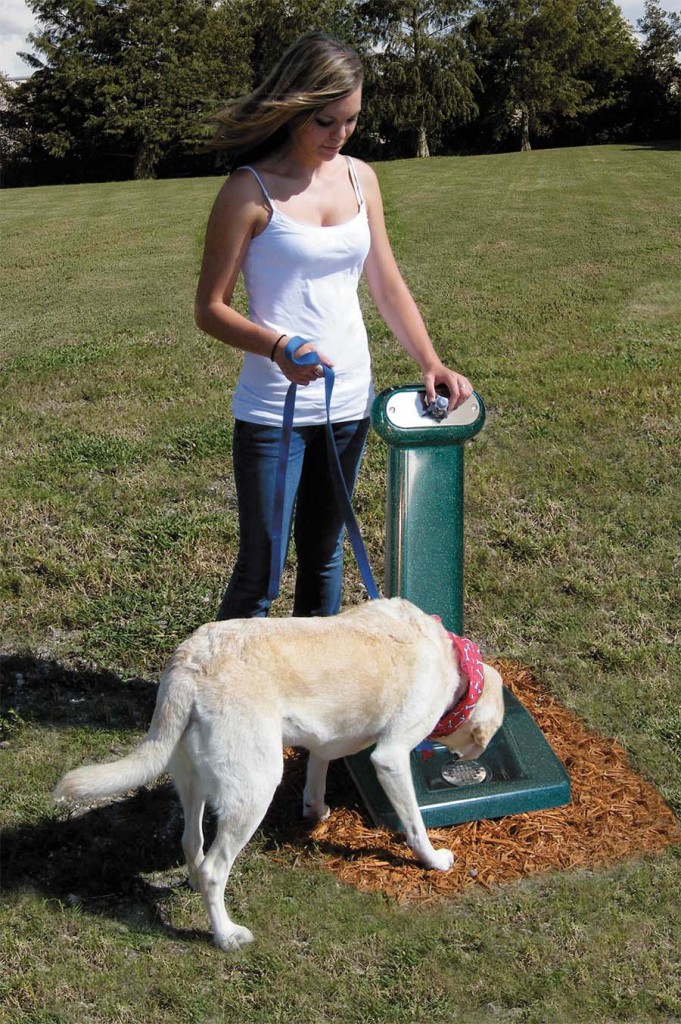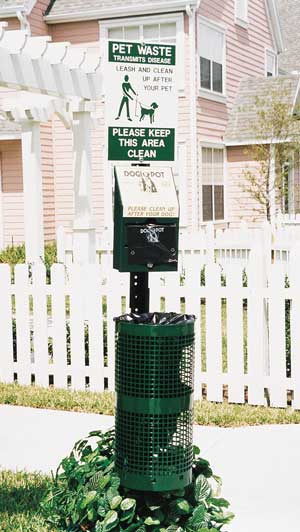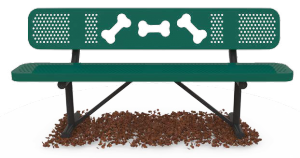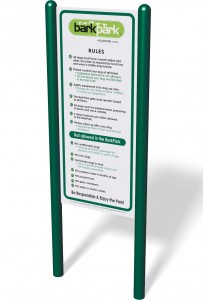Buyer's Guide for Dog Park Equipment
Buyer's Guide for Dog Park Equipment
Buyer's Guide for Dog Park Equipment: What's Inside:
(Click here to download full PDF of Buyer's Guide for Dog Park Equipment) - Why add dog park equipment to your facility - What are the requirements - What your need to know about dog agility equipment - Best practices for dog waste removal - Places for owners to sit - How to raise funds for dog parks - Dog park success stories The purpose of this guide is to give readers an overview of dog park development. There is no reason why a safe, sanctioned dog park cannot exist in any community without the proper planning.
Dog playground equipment is growing in popularity at local parks
Why add dog park equipment to your facility?
What is a dog park? For the purpose of this guide, a dog park is a park specifically designed for and equipped with amenities for dogs, where dogs are invited and not just permitted. Why would you want a dog park in your community? Dog owners are taxpayers, just like your baseball player neighbors and your neighbors who are parents. If your community spends tax dollars to build recreation areas like baseball fields and playgrounds to accommodate their recreation needs, even though not every taxpayer plays baseball or has children, then the community should accommodate the recreation needs of dog owners, too.
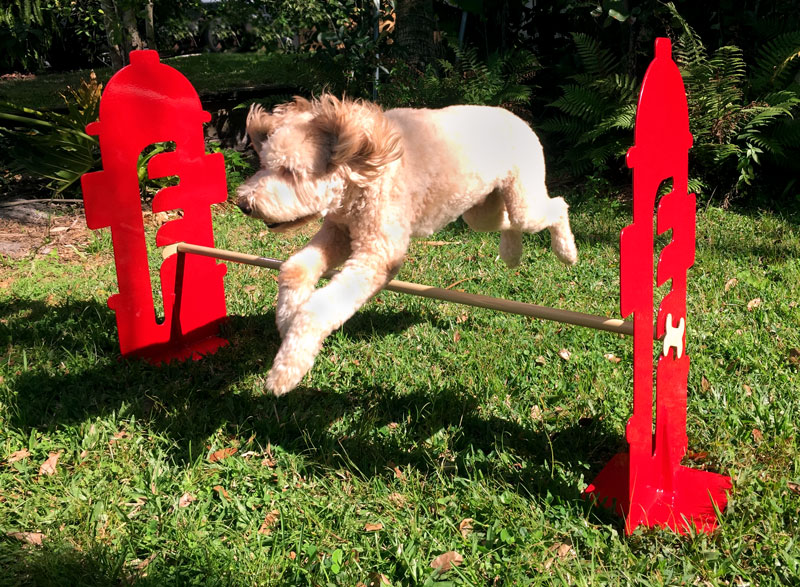
Dogs are natural jumpers and enjoy the challenge.
Other benefits include creating a sense of community, socializing dogs with other dogs which promotes acceptable behavior, decreased crime, human health benefits, increased interest from potential homebuyers who want to move to a community with a dog park, and much more. According to the American Pet Products Association’s National Pet Owners Survey and the Pet Food Institute, more than 65 percent of all American households share their home with at least one cat or dog. Today, the pet dog population is more than 77 million, an increase of more than 15 million since 2001. The Recreation Management Association reports that there are over 1,200 dog parks currently in operation, although the true number is likely higher than that. This is a trend that is booming with a 34 percent increase in dog parks between 2005 and 2010.
What are the requirements?
Dog park leash post
What are the essential elements of a dog park? As in real estate, so with dog parks: location, location, location. If the spot you have your eye on for the dog park is undesirable for people to go there under normal conditions, it will be too undesirable for people with dogs to go there – don’t pick the spot no one wants for your dog park. Small dog parks are fine if you build more than one. Most communities find their small dog park won’t handle all of their visitors and they have to build another one very quickly. Small dog parks are like potato chips – you can’t have just one. The minimum size for a dog park, a small dog park, is one-half of an acre. Ideally, a dog park should be one acre or more in size. You want the ability to put in adequate parking and have access to infrastructure, such as electricity and running water.
What type of enclosure is required? Fencing – every dog park should be fenced in. The fencing should contain the dogs but not hurt them. This means it should not have bars so wide that dogs’ heads can get stuck in them or dogs can escape right through them. It should be durable enough to stand up to a diligent dog chewing on it and not have toxic coatings for dogs. Many fencing types will work, but overall the best fencing choice that will work and is affordable is a chain link fence, six feet tall. Make sure that the fencing chain material is tight to the ground, usually with a solid rod run through the chain link material along the bottom edge, so that dogs cannot push under it and it stays flush with the ground. Entrances need to be carefully designed to ensure that dogs inside the dog park do not easily escape when dogs are entering and leaving the dog park. Experts recommends what they refer to as “doggie airlocks” – double gates with a transition space in between the outside gate and the inside gate. This fencing arrangement contains escaping dogs and allows dogs coming in to be taken off leash so that they are not on leash once they physically enter the interior of the dog park.
What are the best plants and materials? Landscaping choices need to take into consideration that dogs are not people. Surface choices need to be able to be maintained and able to tolerate a certain amount of dog waste. Shrubs and trees must not be toxic to dogs who eat, lick and sniff everything. Gravel, concrete and asphalt are not recommended, as it hurts the dogs’ feet and gets too hot. Mulched wood and wood chips are a very good, affordable choice, and sustainable. Do not use rubber mulch or cocoa bean mulch – these are toxic to dogs. You have to be careful if you are considering artificial turf because it can contain bacteria. It also holds smells and can be hard for removing poop. Reserve artificial turf for rooftop and indoor dog parks. Shade can be natural (trees), artificial (canopies), or a combination of both. Humans and dogs both need shade. Make sure that your tree choices are not toxic for dogs. You will want your canopies and pagodas to be sturdy and durable, easy to maintain, and securely mounted to a foundation so that they do not get blown over on a windy day. Non-essential but nice: If you have the budget for it, you can add artistic elements to dog parks like non-working fire hydrants and sturdy art pieces like statues. A dog wash at the exit is great for washing down hard-playing dogs before they leave to hop in their owners’ cars for the ride home.
Doggie drinking fountain
Adequate water supply is essential Water – every dog park needs to provide fresh water and lots of it for the dogs. Dogs don’t sweat to cast off excess heat like humans do and will dehydrate very quickly if they don’t have lots of fresh water to drink. Your human visitors will need water, too. The best way to provide water for both species is to install a dual-species water fountain, one that has a water fountain on top for the humans and a doggie water fountain at the base for the dogs.
What you need to know about dog agility equipment
Agility equipment is nice to have. Dogs don’t intuitively know how to use it. You should choose specialized dog park agility equipment which can stand up to dog teeth and dog claws and dog urine, along with the inevitable human child or adult that will climb up on them, too. You will want durable equipment that won’t constantly require maintenance or fade from being out in the sun all day. Most dogs need to be trained to use agility equipment. Many people don’t know how to properly use agility equipment, but they can easily learn how to by watching YouTube videos. Or you can offer to teach a class. Once they dogs learn, this agility equipment could become a popular hangout.
There are companies that sell complete dog agility equipment sets along with individual pieces. Just make sure that you purchase sturdy equipment. Note: be sure that all equipment that requires a dog to climb on or sit on must be covered with a special finish that is paw-friendly, slip resistant and repels urine. Urine stains are unsightly and unsanitary and require a special thermoplastic coating. Also, think about dog park kits - this way you can get a discount package deal to get started or even to put in a complete top-of-the line dog park playground. Here is a selection of dog park agility equipment you might want to add to your park to make it a fun and active destination:
Types of dog park products
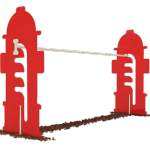
Fire hydrant jump - Fire Hydrant Jump – dogs love to run and jump. Here’s a simple apparatus that lets them do that and can be adjusted for all sizes and skills.

Three hoop dog-shaped jump - Dog Jump – these dog-themed hoop jumps provide three different levels to accommodate dogs of all sizes and skills.

Two hoop dog jump - Three and two-hoop jumps – these jumps also offer different levels for different dogs. There is an imprint of a dog bone included which coincides with the theme of your dog park.
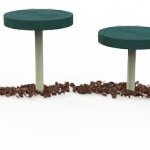
Stepping stones - Stepping Bones – this apparatus is a series of steps for dogs to walk up and down.
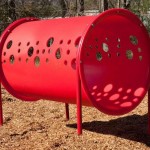
Doggie crawl - Doggie Crawl – a tunnel that dogs can walk or crawl through.
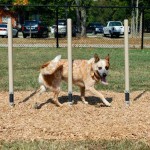
Dog park weave posts - Weave Posts – a popular piece of agility equipment that requires patience and the teaching of specific commands by owners.
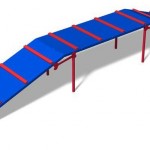
Dog park ramp - Dog Walk Ramp – another piece of agility equipment that dogs love to climb up and over.
|
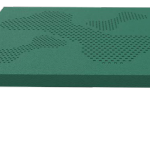
Doggie rest table - Bone Table – a perforated table where dogs can rest or owners can teach additional commands.
Note: be sure that all equipment where a dog is required to climb over or where they can sit is covered with a special finish that is resistant to urine. Urine stains are unsightly and unsanitary and require a special thermoplastic coating to repel.
Best practices for dog waste removal
Dog waste station
Waste Stations -- you can never have enough of these. A dog waste station has a trash container and a poop bag dispenser. Some even have hand sanitizer dispensers! Always install three times more of these than you think you need, if you want to increase compliance with getting people to scoop the poop. And make sure to keep the dispensers full of waste bags. It doesn’t help if you have a dog owner actually try to get a poop bag and find the dispenser empty – there is no way that the poop will get picked up if there are no poop bags to use. According to experts, if people have to walk far to get a poop bag or to dispose of a poop bag, many will not bother. Additionally, if they have to walk far from the poop to get a bag, they might not be able to find the poop again when they return to the area. It can be harder than you think, especially in thick grass. Most people tend to prefer to use opaque poop bags. The solid color does not make it a better poop bags but people just don’t like to look at what they collected in it, so opaque bags tend to be used more willingly than transparent or translucent ones. If you can get ones that are biodegradable as well, that can be a plus when they end up in the landfill.
Dog park themed bench
Places to sit Seating – you can add as much seating as you like for the humans, but tables and picnic tables are not allowed, as food should never be brought into a dog park. If the humans want to eat food, they should eat outside of the dog park. Many dog parks are starting to prohibit the plastic chairs that people have been bringing in, because they leave them behind, break, and don’t stand up to the elements. Permanently installed seating, like dog park benches, is a much better, safer and more durable seating choice.
Dog park signage
Signs with Rules - Signage should be placed just outside and just inside the entrance to the dog park. It should clearly list the dog park rules, what to do in the event a bite happens, and what is considered to be unacceptable behavior that will get the dog and its owner ejected. Rules are essential in a dog park, and you will need to post them in several places to increase the chance that people will read them. Lighting a dog park for night use Lighting is necessary if your dog park will be open before sunrise or after sunset. Remember, many dog owners work full-time and can’t get to the dog park until after work in the evening. Lighting needs to cover the parking lot, the gates and inside the dog park. If the inside of the dog park is not well lit, dog owners will not feel safe and will not be able to find their dogs’ poop to pick it up.
How to raise funds for dog park playground equipment
Speaking of budget, if your public officials won’t fund some or all of the cost of dog park playground equipment, you have many avenues open to you for raising funds, from collection containers, crowdfunding, grants, donations of services, equipment and dollars, yard sales, raffles, and more. You will want to form a Dog Owners Group (D.O.G.) and apply for your D.O.G. to become a non-profit so that donors can get a tax write-off on their donations. You can download detailed information on how to become a 501(c)(3) by going to www.irs.gov and searching for publication 4220 and publication 557. Facebook is a free and effective tool to let people know about your dog park cause, and easy to set up.
Recruit other dog lovers and owners, dog-related businesses (i.e., veterinarians, groomers, pet supply stores, pet sitters, dog walkers) and friends to help you solicit for both funds and support of your dog park cause. Your D.O.G. will want to come up with a political action plan targeted at your public officials and another one targeted to the community at large. Take the “dog intolerant” type of person into account as well. Not everyone loves dogs, hard as that may be to believe.
Respect their viewpoint and focus on the benefits to the community when dealing with these people rather than the benefits to your dogs. Private Dog Parks – most dog parks are government-owned dog parks, as in owned by a city or a county, but there are more and more private dog parks starting to be developed. Private dog parks are generally membership dog parks and tend to have more amenities because of the income coming in from the fees paid by its members. They also have more liability than government owned dog parks.
Government-owned dog parks have protections afforded them by the Recreational Use Immunity Act that private dog parks do not have – private dog parks usually have to purchase commercial liability insurance. Last, but not least, don’t give up! Most D.O.G.s spend on average of two years getting their dog park from an idea to reality. It’s true that where there is a will, there ultimately is a way.
Dog park success stories
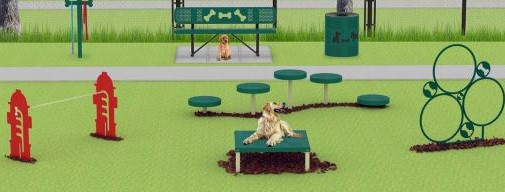
Dog park kits offer several dog park products in a package.
Dog Park Success Stories – California has some of the oldest successful dog parks in the United States, and more dog parks continue to be built there. Texas not only has a lot of dog parks, many of which were constructed in just the past decade, but they have some of the largest in the United States. Harris County in the Houston metropolitan area has built some spectacular dog parks with large dog swims, very well designed doggie airlocks, and acres and acres of space for canines. New Orleans Louisiana came together as a community after Hurricane Katrina to raise funds and build their dog park in City Park, which is not only beautiful architecturally, but has amenities not seen in most dog parks.
Florida has been increasingly adding dog parks since their first dog park was developed in 1996, and they have one of the best dog beaches on the east coast in Lovers Key State Park in Bonita Springs. Gilbert, AZ, has a dog park with a dog poop waste digester that generates methane and powers the dog park lights. Apartment complexes are starting to offer dog parks to lure in dog-owning renters. So are shopping malls. Rooftop dog parks are increasing in number as real estate becomes more precious.
There are also underground dog parks being proposed (like in subway stations). Provincetown MA, has a dog park with some of the finest dog themed art pieces in any one dog park. This artwork was designed by local artists and includes: three-dimensional dog resting platforms, plasma cut metal benches with dog silhouettes, nautical themed waste stations, and more.
Summary
Nearly half the population in the United States owns a dog. People are passionate about their canine friends. Your park or facility will provide a tremendous and popular service to the community by creating a well-built and maintained dog playground equipment.
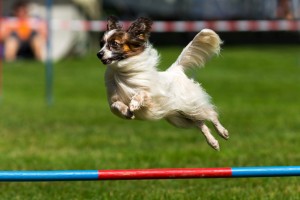
Happy dog in flight
It is not necessary for your dog park to have artwork in it, or every possible amenity, although it certainly adds to the enjoyment of the dog park users when you can incorporate some of these. What is important is that the basic dog park development “bones”, so to speak, are in place, as described in this guide, to help you design a sound dog park that will succeed. As the dog park becomes more popular, and in our experience it will, you can always expand and offer more dog park amenities.
Dogs love to run and play. Owners love to watch their dogs release all that pent-up energy in a controlled and safe environment. It’s a win-win situation for all park and facility managers. This handy guide was brought to you by The Parks and Facilities Catalog.
About The Park and Facilities Catalog
In business since 2001, The Park and Facilities Catalog is a national provider of commercial-grade dog park equipment, dog agility equipment, pet and dog waste stations and dispensers and other dog park products. The company also supplies outdoor site furnishings such as park benches, bicycle parking racks, picnic tables, trash receptacles, aluminum bleachers, lockers and other Division 10 and 12 construction items. Clients include businesses, contractors, architects, parks, schools, universities, shopping centers and office buildings. For more information visit the website at www.theparkcatalog.com
Resources:
American Pet Products Association’s National Pet Owners Survey The Pet Food Institute The Recreation Management Association The Dog Park Development Manual (The Park Catalog recommends you pick up your copy of the Dog Park Development Manual – it’s an extensive 569-guide to planning and building a dog park.)
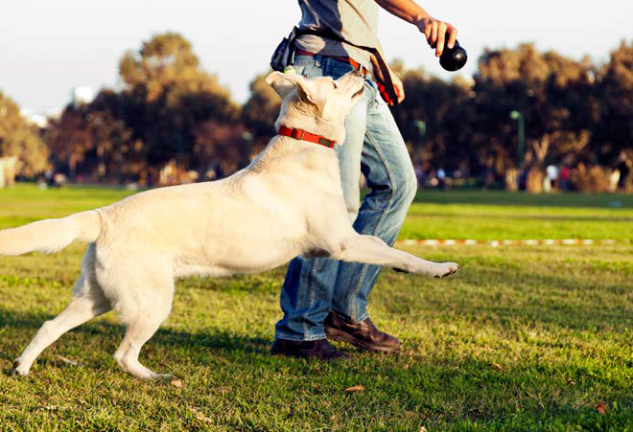
Dogs love parks as much as humans - give them something to do with dog playground equipment



